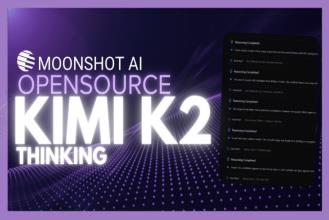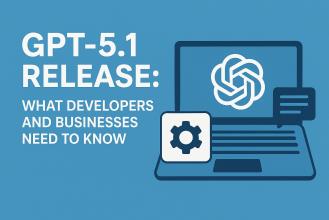Kimi K2 Thinking: Moonshot AI’s Agentic LLM for 200+ Tool Calls
- 18 November, 2025 / by Fosbite
Introduction — What is Kimi K2 Thinking?
Kimi K2 Thinking is Moonshot AI’s purpose-built, reasoning-optimized large language model designed to behave like an agent: planning, calling tools, and executing long multi-step workflows without losing thread. Think of it as an LLM that doesn’t forget mid-run — engineered for long-horizon reasoning and to support stable 200+ sequential tool calls. That endurance comes from a mixture-of-experts architecture and very large context windows, which together let the model hold onto plans, checkpoints, and intermediate results over long-running sessions.
How K2 Thinking Works — Key Technical Highlights
- Mixture-of-Experts (MoE) at scale: K2 uses a MoE approach — many specialized expert subnetworks with a router that picks the relevant ones per token. Reported overall capacity is enormous (roughly a trillion parameters in some configs), yet only a fraction activates per inference. The result: big model power without linear inference cost.
- Very large context windows: Certain variants support extended context windows (tens to hundreds of thousands of tokens). That’s what makes long-running agent orchestration and persistent autonomous agents practical — the model can literally look back at earlier steps and decisions.
- Quantization and deployment options: There are INT4 quantization paths and other compression strategies so teams can run Kimi K2 Thinking more affordably. That makes self-hosted runtimes (Hugging Face, Ollama) and hybrid deployments realistic for smaller ops.
- Tool orchestration: K2 is tuned for calling external tools reliably: web browsing, API requests, code runners, file ops — the usual toolset agents need. The focus is on chaining calls and keeping state intact across the chain.
For hands-on guides and official notes, Moonshot and Together.ai maintain docs and quickstarts: Moonshot AI docs, Together.ai quickstart, and the model listing at Together.ai model page. Those pages show examples, licensing details, and deployment options.
Why 200+ Tool Calls Matter — Real-World Implications
Being able to reliably string together hundreds of tool calls while keeping context changes the game. Instead of one-shot Q&A, you get persistent autonomous agents and true long-horizon workflows. Practically, agents can:
- Plan multi-stage research tasks: gather sources, synthesize findings, iterate queries — and remember earlier notes.
- Run end-to-end development pipelines: generate code, run tests, apply patches, re-run tests — all in a loop until green.
- Manage operational workflows: ingest data, call APIs, update dashboards, re-evaluate anomalies, notify stakeholders.
From working with long-running agents, I can tell you the friction isn’t a single call — it’s state management, error recovery, and observability. K2’s long-context LLM design and emphasis on tool orchestration directly target those pain points, which is why teams ask about best practices for 200+ tool calls in autonomous agents. Learn more about agentic workflow patterns and practical examples in our guide to agentic workflows.
Use Cases — Who Benefits?
- AI researchers: Benchmarks for multi-step reasoning and agentic artificial intelligence, plus experiments like BrowseComp and multi-agent coordination.
- Developers & AI engineers: Building autonomous test suites, CI/CD automation, and assistants that take work from intent to deployment — think CI pipelines where the agent runs tests, patches, and re-runs.
- Enterprises: Automating data pipelines, report generation, and complex integrations where chained API calls and stateful orchestration matter.
Access paths vary: Together.ai hosted endpoints for quick experiments, or self-hosted runtimes on Hugging Face and Ollama for tighter control. If you plan to run Kimi K2 Thinking on Hugging Face in 2025 or deploy with Ollama self-hosting, check the respective docs for licensing and resource guidance.
Risks, Costs, and Governance
Powerful agentic LLMs bring real operational and governance challenges. Plan for them — honestly.
- Safety: Autonomous agents can take unexpected actions. Sandboxing and least-privilege access are non-negotiable.
- Monitoring and auditing: Trace each external call and decision step. Observability and tracing for AI agents makes debugging possible when things go sideways.
- Cost: Long-context LLMs plus hundreds of tool calls drive compute and API spend. Use INT4 quantization, caching, and cost-optimized endpoints to control bills.
- Security & privacy: Protect API keys, PII, and logs. Treat agent outputs as potentially sensitive — and architect key management accordingly.
Also: implement retries, circuit breakers, and clear retry policies. In practice, treating an agent like a distributed system — with observability, backpressure, and fallbacks — keeps it from becoming a brittle proof-of-concept.
Short FAQ
- What does “agentic LLM” mean?
- It’s an LLM designed to act as an autonomous agent: plan steps, invoke tools or APIs, and maintain state across interactions so it can execute multi-step workflows.
- How many tool calls can K2 reliably make?
- Moonshot AI documents stable orchestration of roughly 200–300 sequential calls in a reasoning chain, depending on task complexity and deployment. If you want specifics, read the Moonshot docs: Moonshot docs.
- Where can I test or deploy K2 Thinking?
- Use Together.ai’s hosted endpoints for rapid testing, or go self-hosted via Hugging Face or Ollama depending on licensing and resources. There are step-by-step guides for deploying Kimi K2 Thinking on Hugging Face and for Ollama self-hosting.
- Is the model open source?
- Moonshot publishes documentation and distributes model artifacts on platforms, but full training stacks or some weights may be restricted. Check the official pages for licensing details.
Practical example — A hypothetical autonomous research agent
Picture an agent asked to produce a literature summary and runnable code snippets for a new prompt-engineering paper. A K2-powered autonomous research agent could:
- Search the web for recent papers (tool call).
- Download PDFs and extract key sections (tool call).
- Run code samples locally in a sandbox and capture outputs (tool call).
- Iteratively refine the summary and tests until quality thresholds are met (many chained calls).
Because the agent keeps full context across steps, it can re-run failing experiments, reference earlier findings, and deliver a reproducible artifact without human babysitting. That’s the practical value of a long-horizon reasoning model that supports many sequential tool calls.
Further reading & references
For deeper dives and source material, consult:
- Moonshot AI — Kimi K2 Thinking documentation
- Together.ai — Quickstart and model page
- Hugging Face — model listing and usage
- arXiv — search for long-context and agentic LLM research
Conclusion — Should you consider K2 Thinking?
If your work needs sustained, multi-step tool orchestration — autonomous agents, complex automation pipelines, or long-horizon research assistants — Kimi K2 Thinking is worth evaluating. Start with sandboxed experiments, prioritize observability and security, and treat agent behavior like a distributed system. To be frank: the tooling and pattern decisions you make early (retries, circuit breakers, caching) decide whether you end up with a fragile demo or a reliable product. K2 makes the long-horizon reasoning possible — but it’s the engineering around it that makes it useful in production.Together.ai — Quickstart and model page










